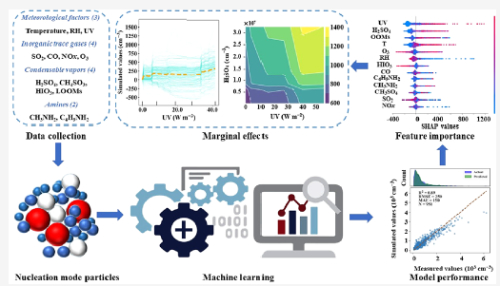

Atmospheric particles have profound implications for the global climate and human health. Among them, ultrafine particles dominate in terms of the number concentration and exhibit enhanced toxic effects as a result of their large total surface area. Therefore, understanding the driving factors behind ultrafine particle behavior is crucial. Machine learning (ML) provides a promising approach for handling complex relationships. In this study, three ML models were constructed on the basis of field observations to simulate the particle number concentration of nucleation mode (PNCN). All three models exhibited robust PNCN reproduction (R2 > 0.80), with the random forest (RF) model excelling on the test data (R2 = 0.89). Multiple methods of feature importance analysis revealed that ultraviolet (UV), H2SO4, low-volatility oxygenated organic molecules (LOOMs), temperature, and O3 were the primary factors influencing PNCN. Bivariate partial dependency plots (PDPs) indicated that during nighttime and overcast conditions, the presence of H2SO4 and LOOMs may play a crucial role in influencing PNCN. Additionally, integrating additional detailed information related to emissions or meteorology would further enhance the model performance. This pilot study shows that ML can be a novel approach for simulating atmospheric pollutants and contributes to a better understanding of the formation and growth mechanisms of nucleation mode particles.
